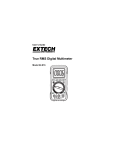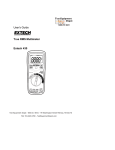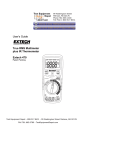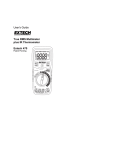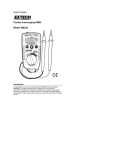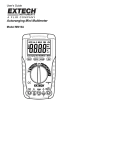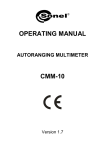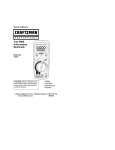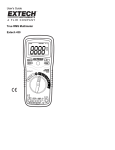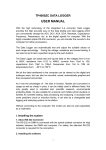Download Triplett 2030 multimeter
Transcript
TRIPLETT Model 2030-C Pocket-Sized DMM INSTRUCTION MANUAL • Do not touch the metallic portion of one test lead if the other test lead is connected to a live circuit. The current from the live circuit may pass through the meter and appear on the unconnected test lead. Failure to observe this warning may result in user injury. • Remove the batteries when the meter may be left unused for longer than 1 month. Chemical leakage from the batteries could damage the meter, leading to user injury. • Do not use the meter if there is evidence of chemical leakage from the batteries. Leakage could damage meter and lead to injury of user. • Do not modify the meter. Changing the design may make the meter unsafe and may result in injury to the user. INTRODUCTION The Triplett 2030-C Pocket Digital Multimeter uses modern technology to provide the user with a convenient, compact, feature packed measuring instrument. The 2030-C measures AC and DC Voltage and Current, tests Diodes, measures Resistance, Frequency and Capacitance and incorporates a Continuity Beeper. It features Autoranging or Manual ranging in the voltage and resistance measuring modes, as well as a battery saving Auto Power Off mode. These abilities make the 2030-C useful in the lab, shop, car, or home.... by the Electrician, Technician, or Hobbyist. FEATURES • • • • • • • • • Use caution when attempting to evaluate if a dangerous voltage is present. The meter will not read AC voltage if it is set to DC, nor will it read DC if it is set to AC. For example, if the meter is set to 200VDC, it will not measure a dangerous AC voltage, even if the probes are inserted into a household AC wall outlet. Autoranging Pocket-Sized DMM 3 3/4 Digit, 4000 Count Display AC/DC Volts to 600V AC/DC Current to 400mA Resistance to 40MΩ CAT II 600V Rating on Voltage Ranges Capacitance Test to 100µF Frequency Range to 10KHz • • • • • • • • • Duty Cycle Diode Check Continuity Beeper Relative Mode Data / Range Hold Auto Power Off Low Battery Indicator Hard, Protective Case One Year Warranty WARNING!!! This meter is NOT to be used to measure High Energy circuits (power circuitry fused at greater than 4KW, such as distribution circuits, power entrance circuits, etc.) or circuits classified by CE as CATEGORY III (CAT III). SAFETY RULES AND WARNINGS • Read all instructions in this manual before using this meter. • Prior to using the meter in any situation which could result in injury to the user, in order to verify that the meter is functional and producing a valid reading, test the meter on a circuit(s) known to have potentials equivalent to the potential that is to be measured. For example, before using the meter to determine if an AC power line is energized with 120VAC, test the meter on a line known to be energized with 120VAC. • Do not exceed the maximum voltage limitations of this meter (see product specifications). Doing so may damage the meter and/or injure the user. • When using this meter in schools and workshops, responsible teachers or skilled personnel must control the usage of this meter. • Follow the recommendations of any Trade Organizations or Regulatory Agencies whose scope encompasses the use of this meter. • Do not attempt to use meter when no display is present on LCD. Doing so may damage the meter and/or injure the user. • Use Caution when the meter is in the HOLD mode. In this mode, the meter will not display a new reading, and consequently, may not indicate the presence of dangerous voltages. i.e. If the meter is in HOLD and is displaying 1 volt, the meter will continue to display 1 volt, even though 500 volts is applied to the meter’s test leads. • When replacing the batteries, dispose of the depleted batteries in accordance with any prevailing safety or environmental regulations. SPECIFICATIONS Display . . . . . . . . . . LCD, Resolution: 3 3/4 digit, 4000 count Size: 0.42" (10.6 mm) high Annunciators: mV, V, Ω, K Ω, M Ω, µF, nF, AC, Hz, KHz, µA, mA , Ranging . . . . . . . . . Polarity . . . . . . . . . . Overrange . . . . . . . Battery . . . . . . . . . . Battery Life . . . . . . . Dimensions . . . . . . . Weight . . . . . . . . . . . Agency Approvals . . RANGE RESOLUTION 0.1mV 4.0V 0.001V 40V 0.01V 400V 0.1V 600V 1V 0.1mV ±1.5% rdg +5 dgt 4.0V 0.001V 40V 0.01V 400V 0.1V 600V 1V 4.0KΩ 0.001KΩ • Always set the meter to the appropriate range or mode before connecting it to the circuitry to be tested. 40KΩ 0.01KΩ 400KΩ 0.1KΩ 4.0MΩ 40MΩ 0.001MΩ 0.01MΩ RANGE 400µA 1µA 40mA 0.01mA • Do not use this meter to make measurements in adverse environments such as rain, snow, fog, or locations with steam, explosive gases or dusts. Doing so may damage the meter and/or injure the user. 400mA 0.1mA • Do not apply more than 600 volts DC/AC rms between the test leads and the earth ground. Doing so may damage the meter and/or injure the user. • If there is any doubt about the condition of the meter (i.e. safe vs unsafe), remove the meter from service and secure it in a location that will prevent its unintentional use. ACCURACY ACCURACY AC CURRENT RANGE RESOLUTION 400µA 0.1µA 4000µA 1µA 40mA 0.01mA 400mA 0.1mA FREQUENCY RESPONSE OVERLOAD PROTECTION 40-400Hz Fast 0.5A/250V Fuse ACCURACY MAX. SENSITIVITY OVERLOAD PROTECTION ±0.02% rdg +2 dgt 5Vrms 600V AC/DC ACCURACY ±2.5% rdg +5 dgt ±2.0% rdg +5 dgt FREQUENCY (AUTORANGE ONLY) RANGE RESOLUTION 50Hz (10Hz min) 0.01Hz 500Hz 0.1 Hz 5KHz 0.001 KHz DUTY CYCLE RANGE 0.1 to 99.9% ACCURACY ±2% rdg +2 dgt MAX. FREQUENCY 10KHz CAPACITANCE (AUTORANGE ONLY) RANGE RESOLUTION ACCURACY ±5.0% rdg +15 dgt • Do not use the meter if it has undergone long-term storage under unfavorable conditions. 4µF 0.001µF • Do not use the meter if it may have been damaged in transport. 40µF 0.01µF 100µF 0.1µF ±3.0% rdg +15 dgt TEST CURRENT 0.1 to 0.5mA ACCURACY Approx. 10% • Do not continue to use meter when the “low battery” symbol is displayed. The displayed reading may be in error and lead the user to believe that no hazard exists, when in fact, dangerous voltages or currents may be present. Fast 0.5A/250V Fuse ±1.5% rdg +5 dgt 0.1nF _ + OVERLOAD PROTECTION ±2.0% rdg +5 dgt 0.01nF • Do not use meter in condensing atmospheres. That is, do not use meter in conditions where ambient temperature and humidity could cause condensation of water inside of meter. Doing so may cause injury to the user. 600V AC/DC ±3.0% rdg +5 dgt 40nF • Do not attempt immediate use of the meter when bringing if from a cold environment to a warm environment. Condensation of water, inside and outside of the meter, may produce dangerous measuring conditions. Allow the meter to warm to room temperature before using. OVERLOAD PROTECTION ±1.0% rdg +3 dgt 400nF • Do not use the meter if it does not appear to work correctly on all ranges and in all modes. 600V AC/DC ±1.5% rdg +5 dgt RESOLUTION 0.1µA 4000µA • Do not touch the tips of the test leads when making a measurement. Do not touch live circuitry when making a measurement. 40-400Hz DC CURRENT • Before using the meter, examine both the meter and the test leads for damage. Do not use the meter if damage (damaged insulation, exposed metal, cracked case, burnt smell, etc.) is evident. • Avoid usage near strong RF fields (radio or television transmitters, etc.). The meter may display readings that are in error, causing the user to misinterpret the hazards present. For example, the meter may indicate a low voltage when high voltages are actually present. OVERLOAD PROTECTION RESISTANCE • This meter is not for use by children. • Avoid usage near strong electrostatic fields (high voltage power lines, televisions, computer monitors, etc.). The meter may display readings that are in error, causing the user to misinterpret the hazards present. For example, the meter may indicate a low voltage when high voltages are actually present. ±1.2% rdg +5 dgt FREQUENCY RESPONSE Input Impedance: 10MΩ on all ranges 0.1Ω • Avoid usage near strong magnetic fields (magnets, loudspeakers, transformers, motors, coils, relays, contactors, electromagnets, etc.). The meter may display readings that are in error, causing the user to misinterpret the hazards present. For example, the meter may indicate a low voltage when high voltages are actually present. ±1.0% rdg +3 dgt 400mV RESOLUTION • Do not use the meter if either the meter or the test leads are wet, either from exposure to the weather, or after cleaning the case of the meter. Doing so may cause injury to the user. OVERLOAD PROTECTION 600V AC/DC 10MΩ ACCURACY 400Ω • Do not rotate the Function switch with the test leads connected to the circuitry to be tested. Doing so may damage the meter and/or injure the user. ±0.8% rdg +3 dgt RESOLUTION RANGE • Never attempt to make voltage measurements with the Function switch set to DIODE , OHM Ω, Continuity Beeper , Frequency (Hz, KHz), or Capacitance . Doing so may damage the meter and/or injure the user. INPUT IMPEDANCE >1000MΩ ACCURACY AC VOLTAGE (600 Volts, 60Hz sine, max input, CAT II criteria) • Do not open this meter for maintenance without first disconnecting the test leads from all external circuitry. • Use caution when working with voltages above 25 volts AC or 35 volts DC. Such voltages may cause a life threatening electrical shock. , H , and AUTO A total of 36 ranges / functions (see following specs) Automatic, minus (-) sign indicates negative polarity LCD displays “OL” 2 - 1.5 Volt, LR-44 or SR-44, Triplett part number 37-51 Approx 150 hours typical 3.2 x 4.8 x 0.8 inch Approx 4 oz. CE CAT II 600 (on voltage ranges only) 400mV RANGE • Use caution when measuring circuits containing capacitors. Capacitors can store dangerous levels of electricity, even when the circuitry which they are in has been disconnected from its power source. _ + DC VOLTAGE (600 Volts max input, CAT II criteria) • Do not use this meter with its battery cover open, its rear case open, or with parts removed. • Repairs and maintenance must only be carried out by qualified service personnel or qualified electricians /technicians who know the dangers of, and the safety rules applicable to this type of equipment. , RESPONSE TIME OVERLOAD PROTECTION Approx. 2 sec ±2.5% rdg +10 dgt 600V AC/DC Approx. 5 sec Approx. 10 sec DIODE TEST MAX DISPLAY 0.999 V OVERLOAD PROTECTION 600V AC/DC CONTINUITY TEST MAX DISPLAY TEST VOLTAGE MAX TEST CURRENT ACCURACY 399.9 Ω Approx. 0.5V Approx. 1mA ±1.0% rdg +3 dgt Beeper Sounds @ less than 30Ω (Approx.) OVERLOAD PROTECTION 600V AC/DC MAKING MEASUREMENTS, GENERAL INFORMATION To make a measurement, open the lid of the meter and rotate the rotary switch to the position appropriate to the quantity to be measured. If appropriate, press the pushbuttons to further define the desired type of measurement. The AutoRanging feature of the meter will automatically select the range which will produce the most accurate reading. Alternately, the user may manually select the range by pressing and releasing the RANGE button. Note the position of the decimal point, and the annunciator (like mV or V) to determine the selected range. Note: The Capacitance ( ) and Frequency (Hz) measurement functions are Autorange only. CONTINUITY BEEPER WARNING!!! REMOVE ALL POWER FROM THE CIRCUIT BEING TESTED. FOLLOW APPROPRIATE PROCEDURES TO REMOVE CHARGE FROM ANY CAPACITORS IN THE CIRCUIT. NEVER CONNECT THE TEST LEADS TO ANY SOURCE OF VOLTAGE WHEN THE METER IS SET TO DIODE. Follow the procedures outlined in the Safety Rules and General Information 1) Set the rotary switch to BEEPER ( Ω ). The selected range should be higher than the expected input value. For example, if a 120 Volt AC household circuit is to be measured, set the meter to the 400 Volt AC range. If a 12 Volt car battery is to be measured, set the meter to the 40 Volt DC range. If the level of the quantity being measured is unknown, always set the meter to the highest appropriate range. 2) Connect the test leads to the circuit to be tested for continuity. To reset the meter from Manual operation to AutoRange operation, press and hold the RANGE button until the meter beeps and AutoRange operation commences (the AUTO annunciator will turn on). 3) If continuity exists, i.e. the resistance between the test leads is less than about 30 Ohms, the beeper will sound, and the LCD display will indicate the resistance of the circuit (up to 400 Ohms). NOTE: Carefully remove the test leads from their storage compartment on the meter and extend them to their full length. Observing the proper polarity (red is positive and black is negative), and following all applicable safety rules, connect the test leads to the circuit to be measured. Read the voltage on the LCD display. CAPACITANCE MEASUREMENT If the meter continuously overranges while attempting to measure voltage, immediately disconnect the test leads from the circuit being measured. Reset the meter to an appropriate range and try making the measurement again, or discontinue using the meter to perform the test. The quantity that you are trying to measure may exceed the capability of this meter, and continued attempts at making a measurement may result in damage to the meter or user injury. When finished making measurements, carefully fold the test leads back into the storage compartment, starting with the leads themselves, and finishing by capturing the tips of the probes with the flip cover and folding it down into the compartment. Before closing the lid of the meter, verify that the test leads are completely enclosed in the storage compartment, and set the rotary switch to the OFF position. When the knob is set to OFF, it aligns with the “power slot” in the lid of the case, allowing the lid to be closed. This feature guarantees that the meter is turned off when the lid is closed, thereby extending the battery life. HOLD A reading appearing in the LCD can be held by pressing and releasing the HOLD button. The HOLD annunciator H will appear in the display when this feature is activated. This feature allows the user to take a measurement for a few seconds, press the HOLD button, and “capture” the reading on the LCD. The HOLD mode is released by pressing the HOLD button again, pressing a different button, or by turning the rotary switch. WARNING!!! DO NOT TURN ROTARY SWITCH IF AN INPUT IS APPLIED TO THE METER AUTO POWER OFF The 2030-C incorporates an Auto Power Off feature designed to lengthen the battery life. If the switch and the buttons are undisturbed over a period of time, the meter will automatically “go to sleep”. Once the meter has “gone to sleep”, a press of one of the buttons or turning the rotary switch will “wake it up”. The time out interval for the 2030-C is approximately 30 minutes. WARNING!!! DO NOT TURN ROTARY SWITCH IF AN INPUT IS APPLIED TO THE METER AC and DC VOLTAGE MEASUREMENTS WARNING!!! THE MAXIMUM INPUT VOLTAGE IS 600 VOLTS AC/DC Follow the procedures outlined in the Safety Rules and General Information Note: The ultra-hi input impedance of the meter may cause the meter’s reading to change randomly until the test leads are connected to a signal source. 1) Set the rotary switch to the AC ( V ) or DC ( V ) voltage mode as desired. If using the AutoRange feature, proceed to Step 2). If using the MANUAL range mode, refer to the instructions given under MAKING MEASUREMENTS, GENERAL INFORMATION. 2) Connect the test leads to the circuit to be measured, observing the proper polarity of the leads. 3) Read the displayed voltage on the LCD. 4) If the minus (-) sign appears (in DC Mode) the positive test lead is connected to a negative polarity. Press the SELECT/REL ∆ button while observing the annunciators in the LCD display. Select the BEEPER mode of operation. WARNING!!! FOLLOW APPROPRIATE PROCEDURES TO REMOVE CHARGE FROM ANY CAPACITORS TO BE TESTED. PERFORMING TESTS ON CHARGED CAPACITORS MAY RESULT IN DAMAGE TO THE METER OR USER INJURY. NEVER CONNECT THE TEST LEADS TO ANY SOURCE OF VOLTAGE WHEN THE METER IS SET TO THE CAPACITANCE MODE. Note: This meter is not intended to perform in-circuit testing of capacitors. 1) Set the rotary switch to . 2) Connect the test leads to the capacitor to be measured, observing the proper polarity of the leads (if important in your application). 3) Read the displayed capacitance on the LCD. NOTE 1: The response time of the capacitor measurement mode lengthens as the capacitance being tested increases. On the highest range (100µF), response time can be 10 seconds or longer. NOTE 2: The 2030-C will not determine if a capacitor is “good” or “bad”...... it only measures the value of the capacitor. A capacitor which measures OL may be Shorted or Leaky. FREQUENCY AND DUTY CYCLE MEASUREMENT WARNING!!! THE MAXIMUM INPUT VOLTAGE IS 600 VOLTS AC Follow the procedures outlined in the Safety Rules and General Information 1) Set the rotary switch to Hz. 2) Connect the test leads to the signal to be measured. 3) Read the displayed frequency on the LCD. 4) To measure Duty Cycle, press the SELECT / REL button. To return to frequency measurement, press the SELECT / REL button again. REL (RELATIVE) MODE The 2030-C incorporates a useful REL Mode that works in the Capacitance and Voltage measuring functions. It does not work in the OHMS, DIODE TEST, CONTINUITY, FREQ, µA, or mA functions. To “null out” the residual capacitance of the 40nF range (which can be as high as 150 digits), turn the rotary switch to the CAP range, observe the LCD reading, and then press the SELECT/REL ∆ button. The displayed reading should drop to 00.00nF. Proceed to measure capacitance as described previously. Similarly, residual readings on the V AC and V DC ranges can be nulled out, or, for special testing purposes, actual AC or DC voltage readings can be nulled to zero, and changes in the input quantity observed as positive and negative deviations from zero. BATTERY REPLACEMENT WARNING!!! PRIOR TO CHANGING THE BATTERIES, DISCONNECT THE TEST LEADS FROM ANY CIRCUITRY THAT THEY MAY BE HOOKED TO AND STORE THE LEADS IN THE CASE. TURN THE METER OFF AND CLOSE ITS LID. 1) Remove the battery cover on the rear of the meter’s case by removing two screws. 2) Remove the batteries and dispose of them in an approved manner. AC and DC CURRENT MEASUREMENTS 3) Insert new batteries, observing proper polarity. WARNING!!! THE MAXIMUM INPUT VOLTAGE IS 250 VOLTS AC/DC Follow the procedures outlined in the Safety Rules and General Information 1) Remove power from the circuit to be tested and connect the test leads of the meter in series with the circuit, observing polarity as appropriate. DO NOT INSERT THE METER INTO CIRCUITS WHERE THE OPEN CIRCUIT VOLTAGE EXCEEDS 250V AC/DC. DOING SO MAY DAMAGE THE METER OR RESULT IN USER INJURY. 2) Set meter to appropriate current range (µA or mA). Press the SELECT/REL ∆ button to select AC or DC measurement. 3) Apply power to circuit being tested and observe the reading on the LCD. 4) If the minus (-) sign appears (in the DC mode) the positive test lead is connected to a negative polarity. 4) Replace the battery cover. FUSE REPLACEMENT WARNING!!! PRIOR TO CHANGING THE FUSE, DISCONNECT THE TEST LEADS FROM ANY CIRCUITRY THAT THEY MAY BE HOOKED TO AND STORE THE LEADS IN THE CASE. TURN THE METER OFF AND CLOSE ITS LID. 1) Remove the battery cover on the rear of the meter’s case by removing two screws. 2) Remove the Wrist Strap from the case. 3) Gently pry the case open, starting at bottom of the case, where the Wrist Strap was attached. Remove back of case. Note how Lid attaches to case. 4) Replace the fuse. 5) Reassemble. 5) Remove power from the circuit being tested before disconnecting the test leads of the meter. STAND / WRIST STRAP RESISTANCE MEASUREMENTS The Wrist Strap can also be used to make the lid of the 2030-C act as a Stand. Flip the lid open, and with it positioned behind the 2030-C, run the handle of the Strap through the slot in the lid, adjusting the handle so that it does not pull back through the slot. Set the meter down . . . the lid acts as a stand. WARNING!!! REMOVE ALL POWER FROM THE CIRCUIT BEING TESTED. FOLLOW APPROPRIATE PROCEDURES TO REMOVE CHARGE FROM ANY CAPACITORS IN THE CIRCUIT. NEVER CONNECT THE TEST LEADS TO ANY SOURCE OF VOLTAGE WHEN THE METER IS SET TO ANY OF THE “OHM” RANGES. Follow the procedures outlined in the Safety Rules and General Information Note: This meter is not intended to perform in-circuit testing of resistors. 1) Set the rotary switch to the OHMs mode ( Ω ). If using the AutoRange feature, proceed to Step 2). If using the MANUAL range mode, refer to the instructions given under MAKING MEASUREMENTS, GENERAL INFORMATION. 2) Connect the test leads to the circuit to be measured, observing the proper polarity of the leads (if important in your application). 3) Read the displayed resistance on the LCD. DIODE TEST WARNING!!! REMOVE ALL POWER FROM THE CIRCUIT BEING TESTED. FOLLOW APPROPRIATE PROCEDURES TO REMOVE CHARGE FROM ANY CAPACITORS IN THE CIRCUIT. NEVER CONNECT THE TEST LEADS TO ANY SOURCE OF VOLTAGE WHEN THE METER IS SET TO DIODE TEST. Follow the procedures outlined in the Safety Rules and General Information Note: This meter is not intended to perform in-circuit testing of diodes. 1) Set the rotary switch to DIODE ( Ω ). Press the SELECT/REL ∆ button ( Ω ) while observing the annunciators on the LCD display. Select the DIODE mode of operation. 2) Connect the test leads to the circuit to be measured, observing the proper polarity of the leads. 3) Read the diode voltage on the LCD. TRIPLETT ONE YEAR LIMITED WARRANTY The Triplett Corporation warrants instruments and test equipment manufactured by it to be free from defective material or workmanship and agrees to repair or replace such products which, under normal use and service, disclose the defect to be the fault of our manufacturing, with no charge within one year of the date of original purchase for parts and labor. If we are unable to repair or replace the product, we will make a refund of the purchase price. Consult the Instruction Manual for instructions regarding the proper use and servicing of instruments and test equipment. Our obligation under this warranty is limited to repairing, replacing, or making refund on any instrument or test equipment which proves to be defective within three years from the date of original purchase. This warranty does not apply to any of our products which have been repaired or altered by unauthorized persons in any way so as, in our sole judgment, to injure their stability or reliability, or which have been subject to misuse, abuse, misapplication, negligence, accident or which have had the serial numbers altered, defaced, or removed. Accessories, including batteries and fuses, not of our manufacture used with this product are not covered by this warranty. To register a claim under the provisions of this warranty, return the instrument or test equipment to Triplett Corporation, Service Department, One Triplett Drive, Bluffton, Ohio 45817, transportation prepaid. Upon our inspection of the product, we will advise you as to the disposition of your claim. ALL WARRANTIES IMPLIED BY LAW ARE HEREBY LIMITED TO A PERIOD OF ONE YEAR FROM DATE OF PURCHASE, AND THE PROVISIONS OF THE WARRANTY ARE EXPRESSLY IN LIEU OF ANY OTHER WARRANTIES EXPRESSED OR IMPLIED. The purchaser agrees to assume all liability for any damages and bodily injury which may result from the use or misuse of the product by the purchaser, his employees, or others, and the remedies provided for in this warranty are expressly in lieu of any other liability Triplett Corporation may have, including incidental or consequential damages. Some states (USA ONLY) do not allow the exclusion or limitation of incidental or consequential damages, so the above limitation or exclusion may not apply to you. No representative of Triplett Corporation or any other person is authorized to extend the liability of Triplett Corporation in connection with the sale of its products beyond the terms hereof. Triplett Corporation reserves the right to discontinue models at any time, or change specifications, price or design, without notice and without incurring any obligation. This warranty gives you specific legal rights, and you may have other rights which vary from state to state. TRIPLETT Triplett Corporation One Triplett Drive 800-TRIPLETT FAX: 419-358-7956 Bluffton, OH 45817 www.triplett.com PN 84-834 Rev B


